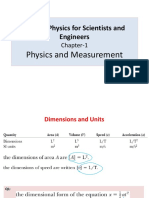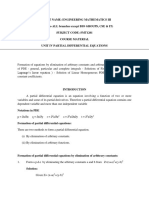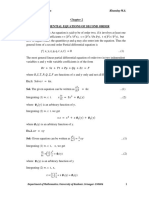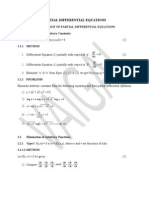0 ratings0% found this document useful (0 votes)
7 viewsAssignment - 4
Uploaded by
sahgyan9Copyright
© © All Rights Reserved
Available Formats
Download as PDF, TXT or read online on Scribd
0 ratings0% found this document useful (0 votes)
7 viewsAssignment - 4
Uploaded by
sahgyan9Copyright
© © All Rights Reserved
Available Formats
Download as PDF, TXT or read online on Scribd
You are on page 1/ 2
Assignment – 4
Advanced Mathematical Physics
Course Code: PHY202
B.Sc. Physics, 2nd Year, Semester – III
Dated: 18.11.2024
Unit – III: Partial Differential Equations
The independent variables will be denoted by x and y and the dependent
variable by z. We have denoted here the partial differential coefficients as
follows:
𝜕𝑧 𝜕𝑧
= p, 𝜕𝑦 = q.
𝜕𝑥
1. Method of forming partial differential equations:
Form a partial differential equation from
i. x2+y2+(z-c)2 = a2 + 10
ii. z = f(x2-y2)
iii. z = (x + a) (y + b)
iv. 2z = (ax + y)2 + b
v. x2 + y2 = (z-c)2 tan2𝛼
2. Solution of equation by direct integration:
𝜕3𝑧
i. Solve 𝜕𝑥 2 𝜕𝑦 = cos(2𝑥 + 3𝑦)
𝜕2𝑧
ii. Solve 𝜕𝑥𝜕𝑦 = 𝑥 2 𝑦
𝜕2𝑧 𝜕𝑧
iii. Solve 𝜕𝑦 2 = 𝑧, if y = 0, z = 𝑒 𝑥 and 𝜕𝑦 = 𝑒 −𝑥
𝜕2𝑧 𝑦
iv. Solve 𝜕𝑥𝜕𝑦 = 𝑥 + 2
3. Lagrange’s Linear Equations is an equation of the type.
𝜕𝑧 𝜕𝑧
P p + Q q = R, where P, Q, R are the functions of x, y, z and 𝜕𝑥 = p, 𝜕𝑦 = q.
Using Lagrange’s Linear Equations method, solve the following partial
differential equation:
i. yq - xp = z
ii. y2p – xyq = x (z – 2y)
iii. (x2 - yz) p + (y2 - zx) q = z2 – xy
4. Solve the following using the Method of Multipliers:
𝜕𝑧 𝜕𝑧
i. (mz – ny) 𝜕𝑥 + (nx – lz) 𝜕𝑦 = ly - mx
𝑦−𝑧 𝑧−𝑥 𝑥−𝑦
ii. p= q=
𝑦𝑧 𝑧𝑥 𝑥𝑦
2 2 2
iii. (x – y – z ) p + 2xyq = 2xz
iv. (y + z) p – (x + z) q = x – y
5. Partial differential equations non-linear in p and q:
i. Solve p2 + q2 = 1
ii. Solve x2p2 + y2q2 = z2
iii. Solve pq + p + q = 0
6. Linear Homogeneous partial differential equations of nth order with
constant coefficients:
i. Solve (D3 – 4D2D' + 3DD'2) z = 0
𝜕2𝑧 𝜕2𝑧 𝜕2𝑧
ii. Solve − 4 𝜕𝑥𝜕𝑦 + 4 𝜕𝑦 2 = 0
𝜕𝑥 2
iii. Solve (D3 – 6D2D' + 11DD'2 - 6 D'3) z = 0
You might also like
- Solutions of Some Problems in Serway PhysicsNo ratings yetSolutions of Some Problems in Serway Physics153 pages
- Unit-5 Higher Order Partial Differential EquationNo ratings yetUnit-5 Higher Order Partial Differential Equation16 pages
- Module 4 - Partial Differential EquationsNo ratings yetModule 4 - Partial Differential Equations8 pages
- II Sem - Module 4 - Partial Diferential Equations - NotesNo ratings yetII Sem - Module 4 - Partial Diferential Equations - Notes17 pages
- 3140610_CVPDE_GTU_Study_Material_e-Notes_Unit---4_25012021084133AMNo ratings yet3140610_CVPDE_GTU_Study_Material_e-Notes_Unit---4_25012021084133AM8 pages
- Previous Year Questions: PDE (2008-2022) : Linear Partial Differential Equations of Order OneNo ratings yetPrevious Year Questions: PDE (2008-2022) : Linear Partial Differential Equations of Order One6 pages
- Ma6351-Tpde - Anna University Important Two MarksNo ratings yetMa6351-Tpde - Anna University Important Two Marks49 pages
- Maths - 3 Assignment - 1 Partial Differential Equations: X A y B 2 2 2 2 Z TNo ratings yetMaths - 3 Assignment - 1 Partial Differential Equations: X A y B 2 2 2 2 Z T2 pages
- Unit V Partial Differential Equations: SolutionNo ratings yetUnit V Partial Differential Equations: Solution18 pages
- Module - 3 Partial Differential EquationsNo ratings yetModule - 3 Partial Differential Equations23 pages
- Unit-Ii: Partial Differential Equations-I: X y Yy XX XyNo ratings yetUnit-Ii: Partial Differential Equations-I: X y Yy XX Xy16 pages
- UE22MA141A_40c31e4e-2ce4-11ed-893d-0a940780a7b0_20230118103607 (1)No ratings yetUE22MA141A_40c31e4e-2ce4-11ed-893d-0a940780a7b0_20230118103607 (1)27 pages
- Unit V Partial Differential Equations: SolutionNo ratings yetUnit V Partial Differential Equations: Solution19 pages
- Assignment of Maths II For Unit 1,2,3 24122014No ratings yetAssignment of Maths II For Unit 1,2,3 241220146 pages
- E-Notes_3891_Content_Document_20250113104813AMNo ratings yetE-Notes_3891_Content_Document_20250113104813AM50 pages
- Z X Q y P Sec Tan Tan : Topic-Wise Objective QuestionsNo ratings yetZ X Q y P Sec Tan Tan : Topic-Wise Objective Questions9 pages
- Transforms and partial differential equationsNo ratings yetTransforms and partial differential equations17 pages
- Partial Differential Equations Question Bank100% (3)Partial Differential Equations Question Bank12 pages
- Department of Mathematics Manipal Institute of Technology, ManipalNo ratings yetDepartment of Mathematics Manipal Institute of Technology, Manipal5 pages
- Mathematics 1St First Order Linear Differential Equations 2Nd Second Order Linear Differential Equations Laplace Fourier Bessel MathematicsFrom EverandMathematics 1St First Order Linear Differential Equations 2Nd Second Order Linear Differential Equations Laplace Fourier Bessel MathematicsNo ratings yet
- Factoring and Algebra - A Selection of Classic Mathematical Articles Containing Examples and Exercises on the Subject of Algebra (Mathematics Series)From EverandFactoring and Algebra - A Selection of Classic Mathematical Articles Containing Examples and Exercises on the Subject of Algebra (Mathematics Series)No ratings yet
- Immediate download A Philosopher Looks at Science 1st Edition Nancy Cartwright ebooks 2024100% (4)Immediate download A Philosopher Looks at Science 1st Edition Nancy Cartwright ebooks 202450 pages
- Chapter 3 Electric Flux Density, Gauss's Law, and DivergenceNo ratings yetChapter 3 Electric Flux Density, Gauss's Law, and Divergence5 pages
- Anchorage of Steel Building Components To ConcreteNo ratings yetAnchorage of Steel Building Components To Concrete7 pages
- 5 Experimental Measurement of MT Coefficients PDFNo ratings yet5 Experimental Measurement of MT Coefficients PDF20 pages
- Endoreversible Thermodynamics: Karl Heinz Homann, Josef Maximilian Burzler, and Sven SchubertNo ratings yetEndoreversible Thermodynamics: Karl Heinz Homann, Josef Maximilian Burzler, and Sven Schubert42 pages
- Property Package Selection Tree - Processdesign Mccormick (Good)No ratings yetProperty Package Selection Tree - Processdesign Mccormick (Good)12 pages
- St. Peter's College Sabayle ST., Poblacion, Iligan City: ObjectiveNo ratings yetSt. Peter's College Sabayle ST., Poblacion, Iligan City: Objective3 pages
- Process Dynamics and Control: By: Gemechu Bushu (AAU)No ratings yetProcess Dynamics and Control: By: Gemechu Bushu (AAU)32 pages
- Research Article: Correlations Between SARA Fractions, Density, and RI To Investigate The Stability of AsphalteneNo ratings yetResearch Article: Correlations Between SARA Fractions, Density, and RI To Investigate The Stability of Asphaltene7 pages
- Unit-1: Dynamics K1 Level Questions Multiple Choice Questions100% (1)Unit-1: Dynamics K1 Level Questions Multiple Choice Questions21 pages
- Scanning Electron Microscopy (SEM) : D.S. SuNo ratings yetScanning Electron Microscopy (SEM) : D.S. Su46 pages
- University of Cambridge International Examinations International General Certificate of Secondary EducationNo ratings yetUniversity of Cambridge International Examinations International General Certificate of Secondary Education20 pages

























































































